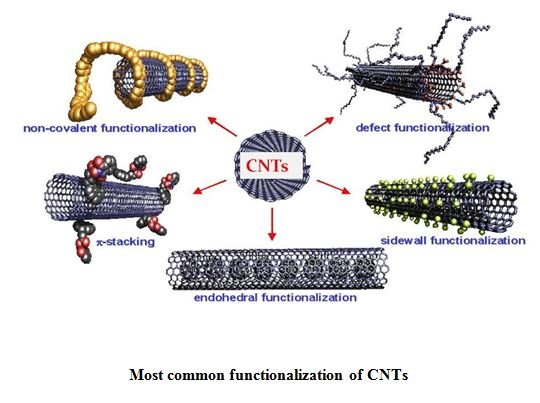Functionalization of carbon nanoparticles: A world of possibilities
Functionalization of carbon nanoparticles: A world of possibilities.

Source
Chemical functionalization of CNT's.
The SWCNT's show an interesting combination of properties due to their structure, the dimensions they present, chemical stability, mechanical and electrical. However, one of the biggest problems is its lack of dispersion, which has hampered certain applications, especially biological applications, among those described as drug-releasing: what has been resolved to the function of the chemical left-hand structures of these structures.
Functionalization is defined as the modification of properties by the adsorption of atoms or molecules on the outer walls of carbon nanotubes. Changes in the physical properties of the surface of these nanoparticles can be obtained, such as solubility and dispersion, which are important in the biological properties of NTC's, since it allows them to have a better interaction with biological molecules.
By means of the chemical oxidation of SWCNT's, various functional groups can be added such as carboxylic acids, amines, and amides. In addition, diazonium chemistry has been used for the introduction of phenyl disulfide, this being a method for easily introducing covalent-type aryl radicals into the SWCNT's. The functionalization of SWCNT's is described in the literature through the electrochemical reaction of diazonium salts, as well as under thermal conditions with aromatic amines, being a method for covalent functionalization of aryl with various substitutions to NTC's.
The SWCNT's can be oxidized by reacting with a mixture of nitric acid and sulfuric acid, with which carboxylic groups are introduced at their ends. Through the chemistry of the carboxylic group and in many cases its activation to adrenal chlorides, it allows the coupling of molecules by means of covalent bonding, forming ester-type bonds and amides. An "invasive" procedure has been described on the exterior walls of the graphite with nitric acid under supercritical water conditions.

Source
The SWCNT's have been used in various reactions such as cycloadditions, diazonium salts, and hydrazines. Recently, functionalization of nanotubes in plasma has been reported, showing advantages compared to chemical treatment, since the surface of the nanotube is easily modified. There are numerous investigations that address the purification of CNTs before they are functionalized.
Purification refers to the removal of metal catalysts from the CNTs coming from some synthesis methods of these nanomaterials. Some of the methods are sulfuric acid treatment, use of nitric acid solution under reflux conditions and using mixtures of these two acids; These treatments can create defects in the side walls of the CNT's, and when they are oxidized, they decrease the surface, the defects that appear when purifying them with these acids alter the mechanical properties of the CNT's. Another method of purification reported is through the use of organic polymers, the treatment with hydrogen peroxide, as well as the use of alternative sources such as microwaves and ultrasound.
The functionalized CNT 's can be used as raw material for reactions in homogeneous solution, of particular importance are the reactions with biological species that need that the nanotubes of carbon function to the hoists are the most dispersed in water or in alcohols.
The functionalization by means of covalent bonds has been very promising since a strong bond is formed between the added functional groups and the SWCNT's. However, CNT's can interact with molecules in different ways. There are two types of functionalization: the covalent in which functional groups are introduced creating a link to the CNT, an example of this is the functionalization with carboxylic acids and amines. The union by means of adsorption is exemplified by anthracene and derivatives, being polyaromatic molecules, presenting n-n type interactions with the CNT's
Non-covalent functionalizations are based on the adsorption of molecules such as surfactants, aromatic compounds, and polymers such as polyacrylamide, polystyrene, among others, which do not alter the properties of CNT's. In the case of MWCNT's and its functionalization with maleic acid and maleic anhydride, it has been shown with excellent results, where its dispersion is improved.
Ultrasound and microwaves are alternative sources that are used to disperse the CNTs in solution, improving the interaction between the various functional groups and the sp2 carbons of MWCNT's. In order to improve dispersion and interfacial adhesion, in addition to ultrasound supercritical fluids have been used in chemical treatments such as oxidation with acids and reaction with free radicals. Microwave irradiation can initiate polymerizations at the NTC 's from an initiating monomer. One of the advantages of the union of the functional groups to the NTC's is that it represents an interesting chemical functionalization since it allows to improve the dispersion of these, which helps in the biological applications.
The most common synthetic route to functionalize the MWCNT 's, as well as the SWCNTs, is based on the reactivity of the walls with carboxylic groups through oxidation with nitric acid. Amidation, esterification or the Friedel-Crafts reaction can also be performed.
References.
- https://www.nanoshel.com/functionalized-multiwalled-carbon-nanotubes/
- https://www.intechopen.com/books/carbon-nanotubes-polymer-nanocomposites/functionalization-of-carbon-nanotubes
- http://pubs.acs.org/doi/abs/10.1021/acs.jpcc.6b08171
- https://www.sciencedirect.com/science/article/pii/S1002007109000495
- https://www.sciencedirect.com/science/article/pii/S0010854515301296
- Carbon Nanotubes and Related Structures, Dirk M. Guldi
- Noncovalent Functionalization of Carbon Nanotubes: Fundamental, Claudia Backes
- Carbon nanotubes, Silvana Fiorito


Why are we wasting time on this when we should be making pokemon?
(Great post, really enjoyed it :P )
Muy interesante el artículo 👌👌